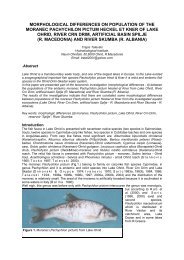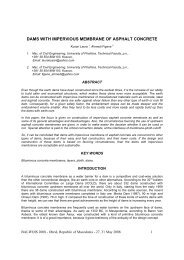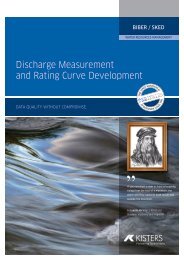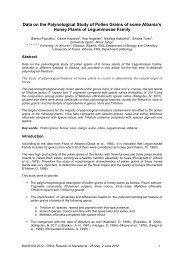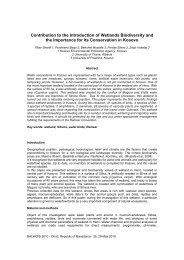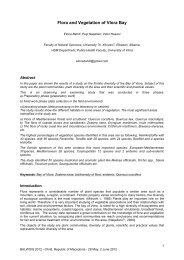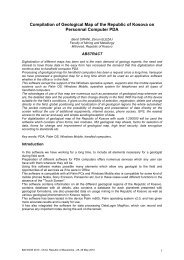The State for Spherule Research in Albania and their Role ... - Balwois
The State for Spherule Research in Albania and their Role ... - Balwois
The State for Spherule Research in Albania and their Role ... - Balwois
You also want an ePaper? Increase the reach of your titles
YUMPU automatically turns print PDFs into web optimized ePapers that Google loves.
<strong>The</strong> <strong>State</strong> <strong>for</strong> <strong>Spherule</strong> <strong>Research</strong> <strong>in</strong> <strong>Albania</strong> <strong>and</strong> <strong>their</strong> <strong>Role</strong> to the<br />
Environment<br />
Prof.Dr. Jakup Hoxhaj 1 , Dr. Fatbardha Cara 1 , Prof.as.Dr. Hasan Kuliçi 2 ,<br />
Dr. Shehribane Abazi 3<br />
1. Geosciences Institute, Polytechnical University of Tirana, 2. <strong>Albania</strong> Geological<br />
Survey,<br />
3. Geology of Kosova<br />
Contact: jakuph2001@yahoo.com<br />
<strong>The</strong> General Data<br />
In the last hundred years microscopic spheroid or de<strong>for</strong>med spheroid objects were found <strong>in</strong> various<br />
geological <strong>for</strong>mations by microm<strong>in</strong>eralogists <strong>and</strong> micropaleontologists. <strong>The</strong> scientists (CsabaHD.1994)<br />
have given them names, as “spherules”, “microspherules”, “spherulites”, “spherolites”, “micrometeorites”,<br />
etc. <strong>The</strong> <strong>in</strong>vestigation of these objects is very difficult, because of <strong>their</strong> very small size. This may be the<br />
reason that they were neglected <strong>for</strong> a long time. <strong>The</strong> <strong>in</strong>vestigation were quite sporadic <strong>and</strong> no<br />
<strong>in</strong>ternational organisatiom has been establuished with the aim of <strong>their</strong> research.<br />
<strong>The</strong> majority of spherulites orig<strong>in</strong>ate from the meteorites exploded <strong>in</strong> the high atmosphere (60-120 km<br />
from the surface of earth. It refers to the three ma<strong>in</strong> types of spherulites: iron, silicate <strong>and</strong> iron-silicate<br />
spherulite that are identical with the tree ma<strong>in</strong> types of meteorites. In this case the surface of the earth is<br />
permanently under a spherulite-drizle, which partially been documented <strong>in</strong> various terrestrial strata. At the<br />
same time, the smaller part of the spherulites may be brough about be impacts of crater-produc<strong>in</strong>g<br />
meteorites, as dissipated melt. We cannot consider imposible the clauds of spherulites to have orig<strong>in</strong>ated<br />
from active impact activity of the Solar System. <strong>The</strong>se clauds were gathered by the planets. It is possible<br />
that <strong>in</strong> the early time of the Solar System more spherulites l<strong>and</strong>ed on the surface of the Earth than <strong>in</strong> the<br />
recent time spitt<strong>in</strong>g through the atmosphere. In early times the meteorite impact activity on the surface of<br />
the Earth was stronger, produc<strong>in</strong>g more vterrestrial impact-orig<strong>in</strong>ated spherulites. In spite of <strong>their</strong> different<br />
orig<strong>in</strong>s the spherulites are identical as to <strong>their</strong> spherical or de<strong>for</strong>med spherical <strong>for</strong>m. <strong>The</strong> diameter of the<br />
spherulites ranmges between 1mm-1000mm. Dur<strong>in</strong>g the histori of the Earth the global occurrence of<br />
spherulites seems to have altogether three abondonce peaks, by extrapolation of certa<strong>in</strong> sporadic local<br />
result.<br />
Spherulites are terrestrial <strong>and</strong> extraterrestrial bodies with different <strong>for</strong>me <strong>and</strong> orig<strong>in</strong>e. <strong>The</strong> ma<strong>in</strong> genetic<br />
types of spherules are:<br />
I. Impact spherules. <strong>Spherule</strong>s issued from impacts of crater produc<strong>in</strong>g meteorites, as dissipated melt.<br />
II. Extraterrestrial spherules. <strong>Spherule</strong>s born from exploded meteorites <strong>in</strong> the high atmosphere.<br />
Interplanetary dust spherules. Interstellar dust spherules.<br />
III. Terrestrial spherules. Volcanic spherules. Very poorly <strong>in</strong>vestigated type, however, potential tools <strong>for</strong><br />
regional <strong>and</strong> world-wide correlation. <strong>Spherule</strong>s of diagenetic orig<strong>in</strong>e. Possible tools <strong>for</strong> regional<br />
correlation. <strong>Spherule</strong>s of biogenic orig<strong>in</strong>e, no tools <strong>for</strong> geological correlation. <strong>Spherule</strong>s of <strong>in</strong>dustrial<br />
orig<strong>in</strong>e (fly<strong>in</strong>g ashes etc.). In this case the connection with the atmospherical pollution is obvious.<br />
<strong>The</strong> first step <strong>in</strong> the world-wide <strong>in</strong>vestigations is to f<strong>in</strong>d reliable methods to dist<strong>in</strong>guish the various<br />
genetic types. (CsabaH.D.1994) It seems that the impact <strong>and</strong> extraterrestrial types would be the global<br />
tools <strong>for</strong> correlation, because the related events are globaly detected. (Great impacts, travers<strong>in</strong>g<br />
meteorite <strong>and</strong> extraterrestrial dust clouds).<br />
<strong>The</strong> <strong>in</strong>terstellar spherules can provide data relat<strong>in</strong>g to the movement <strong>and</strong> position of the Solar System<br />
our Galaxy, the Milky Way, <strong>in</strong> the geological past.<br />
<strong>The</strong> <strong>in</strong>dustrial spherulites (terrestrial), be<strong>in</strong>g directly related to the recent atmospheric pollutions, can<br />
be dist<strong>in</strong>guished among <strong>their</strong> genetic types (of the collesion, extraterrestrial, terrestrial). <strong>The</strong>y are of<br />
different k<strong>in</strong>ds (silicate, irony, silicate-irony) <strong>and</strong> differently spreaded. Based on these parameters (k<strong>in</strong>d,<br />
distribution <strong>and</strong> quantity) we can judge about the environment <strong>and</strong> its pollution rate.<br />
It is a new field of <strong>in</strong>vestigation <strong>in</strong> our country. <strong>The</strong> first results have been obta<strong>in</strong>ed <strong>in</strong> the Kopliku<br />
Square. 21 magnetic <strong>and</strong> only two glassy spherulites were resulted among 23 analised samples.<br />
<strong>The</strong> other samples have been collected around the Rubiku plant <strong>and</strong> the metalurgic plant of Laç <strong>and</strong><br />
<strong>their</strong> analys<strong>in</strong>g is <strong>in</strong> the process. <strong>The</strong> samples have been collected <strong>in</strong> the upper part of the soil, accord<strong>in</strong>g<br />
BALWOIS 2010 - Ohrid, Republic of Macedonia - 25, 29 May 2010<br />
1
to the fixed methodics. A part from the results, the aplication of this new method is of a special<br />
importance <strong>for</strong> the geological-environmental survey of our country.<br />
<strong>The</strong> valuable data by this method are obta<strong>in</strong>ed <strong>in</strong> USA, Ch<strong>in</strong>a, Japan, Hungary etc. Although aplicative<br />
of this method is still <strong>in</strong> the first steps. <strong>The</strong> character of the environment is determ<strong>in</strong>ed by micro <strong>and</strong><br />
macro elements of spherulites. <strong>The</strong>ir morphology is also evaluated as important element.<br />
First <strong>in</strong>strumental spherule results.<br />
For the first time <strong>in</strong> this year 1997, are found spherules <strong>in</strong> <strong>Albania</strong>. 25 <strong>Albania</strong>n rock samples collected at<br />
the lowl<strong>and</strong> of Adriatic see have been exam<strong>in</strong>ed. they are represented <strong>in</strong> four sections (sections 1, 2, 3,<br />
4,), that belong to the plio-quaternary deposition <strong>in</strong> Kopliku region<br />
(<strong>in</strong> northwestern part of <strong>Albania</strong>).<br />
<strong>The</strong> samples are taken from Pliocene, Pleistocene <strong>and</strong><br />
Holocene age. <strong>The</strong>ir material consists of different k<strong>in</strong>d of clays,<br />
silts, s<strong>and</strong>s <strong>and</strong> s<strong>and</strong>stones (HoxhajJ.CaraF.1997).<br />
Holocene samples have no spherule content.<br />
We have found 9 black, rounded, magnetic spherules <strong>in</strong> the<br />
Pleistocene age samples.<br />
Pliocene samples have remarkable spferule content, 21<br />
magnetic <strong>and</strong> 2 glassy spherules have been found <strong>in</strong> the<br />
samples. Interest<strong>in</strong>g fossil assemblages also can be found <strong>in</strong> the<br />
Pliocene age samples. they are: g a s t r o p o d e , b i v a l v o r , d e n t a l i u m e , p t e r o p o d<br />
(macrofauna) <strong>and</strong> f o r a m i n i f e r (mikrofauna). Accord<strong>in</strong>g to these <strong>for</strong>ms was determ<strong>in</strong>ed the<br />
piaçensiane <strong>and</strong> astiane age, belong<strong>in</strong>g to the 2 facies: clay-silt (piaçensiane) <strong>and</strong> s<strong>and</strong> - s<strong>and</strong>stone<br />
(astiana). <strong>for</strong> <strong>in</strong>stance some species: p e c t i n a t a p l i a s t i e n s i s , f l a b i l l i p e c t e n b o s n i<br />
a s c k i i e t c.<br />
Other posibility results <strong>in</strong> the Gashi Region.<br />
Gashi zone is the facial structure unit, component part of Albanide, with its north analogy Dormitory zone.<br />
<strong>in</strong> the south, it contacts with Alpe zone <strong>and</strong> do not go further. This<br />
contact is the over thrust <strong>for</strong>m.<br />
Four <strong>for</strong>mations take part <strong>in</strong> the geological structure (eastern<br />
part) of Gashi region. <strong>The</strong>y are: 1. sedimentary-volcano <strong>for</strong>mation of<br />
Çeremi (S1 1-2 -D1 1 ). 2. gabro-granodioritic <strong>for</strong>mation of Trokuzi (D2-<br />
P1). 3. volcano-sedimentary <strong>for</strong>mation of Rupa-Sylbica (P2). 4.<br />
Hungary, 1996<br />
BALWOIS 2010 - Ohrid, Republic of Macedonia - 25, 29 May 2010<br />
Itali, 1998<br />
conglomerate-s<strong>and</strong>stone quartzous <strong>for</strong>mation of Kershi i<br />
Vujkut-Qafa e Ali Çeles (T1).<br />
<strong>The</strong> age of these <strong>for</strong>mations was determ<strong>in</strong>ed by the conodonts<br />
<strong>and</strong> stratigraphical position. All samples are taken <strong>in</strong> the same<br />
situation with conodont’s sections. Two of the <strong>for</strong>mations have been object <strong>for</strong> the spherule research<br />
(<strong>for</strong>mations no: 1 <strong>and</strong> 3).<br />
62 rock samples are taken <strong>in</strong> this region. 35 samples are collected from limestone <strong>and</strong> the others (27)<br />
from schists <strong>and</strong> carbonate schist’s.<br />
<strong>The</strong> state of <strong>Albania</strong> <strong>Spherule</strong> <strong>Research</strong><br />
Albanides are a component part of the Apenn<strong>in</strong>e-D<strong>in</strong>aride-Albanide-Helenide cha<strong>in</strong>, which build up the<br />
southern part of the Mediterranean Alp<strong>in</strong>e orogenic belt. <strong>The</strong>y are characterised by a vast development of<br />
the carbonate, terrigenous <strong>and</strong> evaporitic <strong>for</strong>mation as well as by the powerfully development of the<br />
magmata’s mostly ophiolitic one. <strong>The</strong> strike of geological structures is NW - SE, show<strong>in</strong>g asymmetric<br />
folds, generally reversed to west. Thrust<strong>in</strong>g tectonics is the ma<strong>in</strong> structural feature of Albanides.<br />
In Mediterranean area, the alp<strong>in</strong>e orogeneses began with <strong>in</strong>tercont<strong>in</strong>ental rift<strong>in</strong>g <strong>in</strong> the early<br />
Brazil, 2000<br />
Mesozoic times, locally followed by a major pulse of oceanic floor spread<strong>in</strong>g. It is ended with<br />
tectonic emplacement of ophiolites on to the cont<strong>in</strong>ental marg<strong>in</strong>s dur<strong>in</strong>g the Late Jurassic to Early<br />
Cretaceous, correspond<strong>in</strong>g to the major fold<strong>in</strong>g event. It is followed by subsequent fold<strong>in</strong>g phase dur<strong>in</strong>g<br />
the Eocene <strong>and</strong> Oligocene. Late tectonic movements took place <strong>in</strong> the Miocene - Pliocene. In the<br />
geological structure, Paleozoic sediments have a limited distribution, be<strong>in</strong>g exposed ma<strong>in</strong>ly <strong>in</strong> the eastern<br />
areas. A great development has the Mesozoic deposits ma<strong>in</strong>ly of carbonate composition, spread to South<br />
2<br />
Hungari,
- western, central <strong>and</strong> northern part of <strong>Albania</strong>. <strong>The</strong> deposits of Cenozoic - Quaternary age, ma<strong>in</strong>ly of<br />
terrigene character, have <strong>their</strong> ma<strong>in</strong> development <strong>in</strong> the Western <strong>and</strong> partially <strong>in</strong> the Central region.<br />
In relation to the Jurassic-Cretaceous fold<strong>in</strong>g phase, the External <strong>and</strong><br />
Internal Tectonic zones are dist<strong>in</strong>guished <strong>in</strong> <strong>Albania</strong>. <strong>The</strong> external zones<br />
(Krasta-Cukali, Alpe, Kruja, Jonian <strong>and</strong> Sazani) show a cont<strong>in</strong>uous<br />
sedimentation rang<strong>in</strong>g from Triassic to Eocene. In the Internal Albanides,<br />
largely affected by Jurassic-Cretaceous fold<strong>in</strong>g phase, the Mirdita, Korabi,<br />
Gashí tectonic zones are evidenced.<br />
For three years (HoxhajJ.CaraF.1997) we have collected 394 samples<br />
from these sediments <strong>in</strong> <strong>Albania</strong> <strong>for</strong> the future spherule research. <strong>The</strong>se<br />
samples are <strong>in</strong> the Geological Institute of Hungary. We have also 50 th<strong>in</strong><br />
sections from these <strong>Albania</strong>n sediments <strong>for</strong> the paleontological <strong>and</strong><br />
sedimentilogical correlations. After discuss with the Hungarian participation’s of<br />
Brazil, 2000<br />
the IGCP 384 it seems that the deep neritic, pelagic <strong>and</strong> bathyal sediments are<br />
the bests <strong>for</strong> spherule correlation horizons.<br />
<strong>The</strong> question of the future is how to organize the laboratory work of the sediments <strong>and</strong> <strong>in</strong>strumental<br />
analyses of the spherules.<br />
It is a new field of <strong>in</strong>vestigation <strong>in</strong> our country. <strong>The</strong> first results have been obta<strong>in</strong>ed <strong>in</strong> the Kopliku<br />
square. 21 magnetic <strong>and</strong> only two glassy spherulites were resulted among 23 analyzed samples. <strong>The</strong><br />
samples are taken from, Pleistocene <strong>and</strong> Holocene age. <strong>The</strong>ir material consists of different k<strong>in</strong>d of clays,<br />
silts, s<strong>and</strong>s <strong>and</strong> s<strong>and</strong>stone. Holocene samples have no spherule content. We have found 9 black,<br />
rounded, magnetic spherules <strong>in</strong> the Pleistocene age samples.<br />
Pliocene samples have remarkable spherule content, 21 magnetic <strong>and</strong> 2 glassy spherules have been<br />
found <strong>in</strong> the samples. Interest<strong>in</strong>g fossil assemblages also can be found <strong>in</strong> the Pliocene age samples. they<br />
are: g a s t r o p o d e , b I v a l v o r , d e n t a l i u m e , p t e r o p o d (macrofauna) <strong>and</strong> f o r a m i n i f e r<br />
(mikrofauna). Accord<strong>in</strong>g to these <strong>for</strong>ms was determ<strong>in</strong>ed the piaçensiane <strong>and</strong> astiane age, belong<strong>in</strong>g to<br />
the 2 facies: clay - silt (piaçensiane) <strong>and</strong> s<strong>and</strong> - s<strong>and</strong>stone (astiana). For <strong>in</strong>stance some species: p e c t i<br />
n a t a p l i a s t i e n s i s , f l a b i l l i p e c t e n b o s n i a s c k i i e t c.<br />
<strong>Albania</strong>n territory is part of the Mediterranean tectonic system <strong>and</strong> it belongs to the D<strong>in</strong>aride-Helenide<br />
realm.<br />
<strong>The</strong> geological structures developed <strong>in</strong> the <strong>Albania</strong>n segment are named Albanides.<br />
<strong>The</strong> strike of geological structures is NW-SE, show<strong>in</strong>g asymmetric folds, generally reversed to west<br />
Thrust<strong>in</strong>g tectonics is the ma<strong>in</strong> structural feature of Albanides.<br />
Regional transversal fault as those of Shkoder-Peja, Elbasan-Diber divide the Albnide structures <strong>in</strong><br />
several segments.<br />
<strong>The</strong> Albanides show a normal cont<strong>in</strong>uation <strong>in</strong> South toward the Helenide <strong>in</strong> Greece, <strong>in</strong> North toward<br />
the D<strong>in</strong>aride <strong>in</strong> Yugoslavia.<br />
In Mediterranean area, the alp<strong>in</strong>e orogeneses began with <strong>in</strong>tercont<strong>in</strong>ental rift<strong>in</strong>g <strong>in</strong> the Early Mesozoic<br />
times, locally followed by a major pulse of oceanic floor spread<strong>in</strong>g. It is ended with tectonic emplacement<br />
of ophiolites on to the cont<strong>in</strong>ental marg<strong>in</strong>s dur<strong>in</strong>g the Late Jurassic to Early Cretaceous, correspond<strong>in</strong>g to<br />
the major fold<strong>in</strong>g event. It is followed by subsequent fold<strong>in</strong>g phase dur<strong>in</strong>g the Eocene <strong>and</strong> Oligocene.<br />
Late tectonic movements took place <strong>in</strong> the Miocene-Pliocene.<br />
In the geological structure, Palaeozoic sediments have a limited distribution, be<strong>in</strong>g exposed ma<strong>in</strong>ly <strong>in</strong><br />
the eastern areas. A great development has the Mesozoic deposits ma<strong>in</strong>ly of carbonate composition,<br />
spread to South-western, Central <strong>and</strong> Northern part of <strong>Albania</strong>. <strong>The</strong> deposits of Ca<strong>in</strong>ozoic-Quaternary<br />
age, ma<strong>in</strong>ly of terrigene character, have <strong>their</strong> ma<strong>in</strong> development <strong>in</strong> the Western <strong>and</strong> partially <strong>in</strong> the<br />
Central region.<br />
In relation to the Jurassic-Cretaceous fold<strong>in</strong>g phase, the External <strong>and</strong> Internal Tectonic zones are<br />
dist<strong>in</strong>guished <strong>in</strong> <strong>Albania</strong>. <strong>The</strong> external zones (Krasta-Cukali, Alps, Kruja, Jonian <strong>and</strong> Sazani) show a<br />
cont<strong>in</strong>uous sedimentation rang<strong>in</strong>g from Triassic to Eocene. In the Internal Albanides, largely affected by<br />
Jurassic- Cretaceous fold<strong>in</strong>g phase, the Mirdita, Korabi, Gashí tectonic zones are evidenced.<br />
A wide spread<strong>in</strong>g has the magmatic, volcanic <strong>and</strong> plutonic rocks, chiefly of Mesozoic <strong>and</strong> less of the<br />
Palaeozoic age. <strong>The</strong> most conspicuous feature of the geological structure of the Albanides is the<br />
development of the Ophiolitic <strong>for</strong>mation. <strong>The</strong> ophiolitic <strong>for</strong>mation is the major geologic <strong>and</strong> metallogenic<br />
reference <strong>for</strong> the <strong>Albania</strong>n territory.<br />
BALWOIS 2010 - Ohrid, Republic of Macedonia - 25, 29 May 2010<br />
3
For two years we have collected 380 samples from these sediments <strong>in</strong> <strong>Albania</strong> <strong>for</strong> the future spherule<br />
research. Samples are here <strong>in</strong> the Geological Institute of Hungary. We have also 50 th<strong>in</strong> sections from<br />
these <strong>Albania</strong>n sediments <strong>for</strong> the paleontological <strong>and</strong> sedimentological correlations.<br />
After discuss with the Hungarian participations of the IGCP 384 it seems that the deep neritic, pelagic<br />
<strong>and</strong> bathyal sediments are the bests <strong>for</strong> spherule correlation horizon.<br />
<strong>The</strong> question of the future is to organize the laboratory work of the sediments <strong>and</strong> <strong>in</strong>strumental<br />
analysis of the spherules.<br />
<strong>Spherule</strong> <strong>Research</strong> <strong>in</strong> <strong>Albania</strong>.<br />
For five years (1996-2000) we have collected 438 samples from the sediments <strong>in</strong> <strong>Albania</strong> <strong>for</strong> the spherule<br />
research. 367 of them are <strong>in</strong> the Geological Institute of Hungary <strong>and</strong> 70 to Milano University (number 368-<br />
438). We have also 50 th<strong>in</strong> sections from these <strong>Albania</strong>n sediments <strong>for</strong> the paleontological <strong>and</strong><br />
sedimentological correlations. After discussion with other participation’s of the IGCP 384 it seems that the<br />
deep neritic, pelagic <strong>and</strong> bathial sediments are the bests <strong>for</strong> spherule correlation horizons.<br />
<strong>The</strong> first results (from~150 samples that are analised <strong>in</strong> Budapest) have been obta<strong>in</strong>ed <strong>in</strong> the Kopliku<br />
square. 21 magnetic <strong>and</strong> only two glassy spherulites were resulted among 23 analised samples. <strong>The</strong><br />
samples are taken from, Pleistocene <strong>and</strong> Holocene age. <strong>The</strong>ir material consist of different k<strong>in</strong>d of clays,<br />
silts, s<strong>and</strong>s <strong>and</strong> s<strong>and</strong>stoun. Holocen samples have no spherule content. We have found 9 black, rounded,<br />
magnetic spherules <strong>in</strong> the Pleictocene age samples.<br />
Interest<strong>in</strong>g fossil assemblages also can be found <strong>in</strong> the Pliocen age samples. they are: g a s t r o p o d<br />
e , b i v a l v o r , d e n t a l i u m e , p t e r o p o d (macrofauna) <strong>and</strong> f o r a m i n i f e r (mikrofauna).<br />
accord<strong>in</strong>g to this <strong>for</strong>ms was determ<strong>in</strong>ed the piaçensiane <strong>and</strong> astiane age, belong<strong>in</strong>g to the 2 facies: clay-<br />
silt (piaçensiane) <strong>and</strong> s<strong>and</strong>-s<strong>and</strong>stone (astiana). For <strong>in</strong>stance some species: p e c t i n a t a p l i a s t i e<br />
n s i s , f l a b i l l i p e c t e n b o s n i a s c k i i e t c.<br />
We consider, with favorable presence of spherules, these geological events: Pliocen <strong>and</strong> Pleistocene<br />
age, Upper Eocen, K/T boundary, Triasic-Jurasic transition, Permian-Triasic transition.<br />
<strong>Spherule</strong> research possibility <strong>in</strong> Permian-Triassic, Triassic–Jurassic <strong>and</strong> Cretaceous-Tertiary<br />
boundary <strong>in</strong> Albanides<br />
An overview of the geology, Sazani Zone, Jonian Zone, Kruja Zone, Krasta - Cukali Zone, Alpe Zone,<br />
Mirdita Zone, Korabi Zone, Gashi Zone, <strong>Albania</strong>n - <strong>The</strong>salian <strong>in</strong>ner bas<strong>in</strong>, <strong>The</strong> pre-Adriatic depression,<br />
<strong>The</strong> question of the future<br />
For four years (1996-1999) we have collected 438 samples from the sediments <strong>in</strong> <strong>Albania</strong> <strong>for</strong> the<br />
spherule research. 367 samples are <strong>in</strong> the Geological Institute of Hungary <strong>and</strong> 70 to your <strong>in</strong>stitution<br />
(number 368-438). We have also 50 th<strong>in</strong> sections from these <strong>Albania</strong>n sediments <strong>for</strong> the paleontological<br />
<strong>and</strong> sedimentological correlations. After discussion with the hungarian participation’s of the IGCP 384 it<br />
seems that the deep neritic, pelagic <strong>and</strong> bathial sediments are the bests <strong>for</strong> spherule correlation horizons.<br />
<strong>The</strong> first results (from~150 samples that are analised <strong>in</strong> Budapest) have been obta<strong>in</strong>ed <strong>in</strong> the Kopliku<br />
square. 21 magnetic <strong>and</strong> only two glassy spherulites were resulted among 23 analised samples. <strong>The</strong><br />
samples are taken from, Pleistocene <strong>and</strong> Holocene age (HoxhajJ.,CaraF.,SoltP.,DonG.1998). <strong>The</strong>ir<br />
material consist of different k<strong>in</strong>d of clays, silts, s<strong>and</strong>s <strong>and</strong> s<strong>and</strong>stoun. Holocen samples have no spherule<br />
content. We have found 9 black, rounded, magnetic spherules <strong>in</strong> the Pleictocene age samples.<br />
Pliocen samples have remarkable spherule content, 21 magnetic <strong>and</strong> 2 glassy spherules have been<br />
found <strong>in</strong> the samples. Interest<strong>in</strong>g fossil assemblages also can be found <strong>in</strong> the Pliocen age samples. they<br />
are: g a s t r o p o d e , b i v a l v o r , d e n t a l i u m e , p t e r o p o d (macrofauna) <strong>and</strong> f o r a m i n i f e r<br />
(mikrofauna). Accord<strong>in</strong>g to this <strong>for</strong>ms was determ<strong>in</strong>ed the piaçensiane <strong>and</strong> astiane age, belong<strong>in</strong>g to the<br />
2 facies: clay - silt (piaçensiane) <strong>and</strong> s<strong>and</strong> - s<strong>and</strong>stone (astiana). For <strong>in</strong>stance some species: p e c t i n a t<br />
a p l i a s t i e n s i s , f l a b i l l i p e c t e n b o s n i a s c k i i e t c.<br />
We, as you, consider, with favorable presence of spherules, these geological events: Pliocen <strong>and</strong><br />
Pleistocene age. Upper Eocen. K/T boundary. Triasic-Jurasic transition. Permian-Triasic transition.<br />
<strong>The</strong> Cenomanian-Turonian boundary <strong>in</strong> <strong>Albania</strong> <strong>and</strong> the possibility <strong>for</strong> the spherule research.<br />
<strong>The</strong> Albanides are derived <strong>in</strong>to External Zones, show<strong>in</strong>g a cont<strong>in</strong>uous sedimentation rang<strong>in</strong>g from Trias to<br />
Eocene, <strong>and</strong> Internal Zones that <strong>in</strong>clude the Mirdita ophiolites, which were folded dur<strong>in</strong>g the Jurassic <strong>and</strong><br />
Cretaceous tectonic phases.<br />
BALWOIS 2010 - Ohrid, Republic of Macedonia - 25, 29 May 2010<br />
4
<strong>The</strong>re is Upper Cretaceous (Cenomanian-Turonian boundary) <strong>in</strong> some <strong>Albania</strong> Geological Zones.<br />
Turonian-Senonian age, thickness 80-150 m, conglomerate, <strong>in</strong> the Korabi Zone. Senomanian age,<br />
limestone, thickness 100-180 m, <strong>in</strong> the Mirdita Zone, <strong>and</strong> Turonian-Senonian, compact limestone too.<br />
Cenomanian-Turonian, (HoxhajJ.,CaraF.,SoltP.,DonG.1998) thicknees 50 m, sharly limestone, <strong>in</strong> the<br />
Alpe zone. Cenonomanian limestone of Kruja Zone. Cenomanian-Turonian, crystall<strong>in</strong>e limestone <strong>and</strong><br />
lam<strong>in</strong>ated limestone of Jonike Zone, 250-350 m. thickness. Limestone of Turonian-Senonian age <strong>in</strong> the<br />
Sazani Zone.<br />
It seems that the Cenomanian-Turonian boundary is a very <strong>in</strong>terest<strong>in</strong>g geological episode <strong>in</strong> the<br />
<strong>Albania</strong> Region (Alpe <strong>and</strong> Jonike Zones). In the some places is very important to <strong>in</strong>vestigate to <strong>Spherule</strong><br />
<strong>Research</strong>.<br />
In the Mediterranean Region (papers presented to the Annual Meet<strong>in</strong>g of IGCP 384, 1998, Budapest,<br />
presentation of Colombetti-Nicolodi, Italy) the Cenomanian-Turonian transitions (impact event) is detected<br />
<strong>in</strong> Spa<strong>in</strong> <strong>and</strong> Italy, too.<br />
It would be an excellent th<strong>in</strong>k, if we could be able to f<strong>in</strong>d this event <strong>and</strong> <strong>in</strong> <strong>Albania</strong>.<br />
We have collected about 30 samples from the sediments of Jonike Zone <strong>for</strong> the future spherule<br />
research. No results until now. I th<strong>in</strong>k to cont<strong>in</strong>ue the sampl<strong>in</strong>g processes <strong>for</strong> the future results.<br />
References:<br />
Csaba H. Detre. 1994: “Spherulites-New Tool <strong>for</strong> Global Geological <strong>and</strong> Planetological Correlation”.<br />
International Meet<strong>in</strong>g (micrometeorite) <strong>in</strong> the Carpathian Bas<strong>in</strong>. Budapest, 31 October-1 November.<br />
Hoxhaj J., Cara F. 1996: “<strong>Albania</strong>n <strong>Spherule</strong> <strong>Research</strong>. <strong>Albania</strong>n-Hungarian co-operation <strong>in</strong> the<br />
framework of IGCP 384”. “Impact <strong>and</strong> Extraterrestrial <strong>Spherule</strong>s” Budapest, Hungary. (<strong>in</strong> <strong>Albania</strong>n <strong>and</strong><br />
English).<br />
Hoxhaj J., Cara F., Spaho M., David A., Dudas G. 1997: “<strong>The</strong> First Results of the <strong>Albania</strong>n <strong>Spherule</strong><br />
<strong>Research</strong>”, në anglisht. IGCP 384, Work<strong>in</strong>g Group Meet<strong>in</strong>g, 25-27 February 1997. Debrecen, Hungary.<br />
Geological Institute of Hungary.<br />
Hoxhaj J., Cara F. 1997: “<strong>The</strong> First Instrumental Results of Plio-Pleistocene`s <strong>Spherule</strong>s <strong>in</strong> <strong>Albania</strong>”, në<br />
anglisht. IGCP Projekt 384 “Impact <strong>and</strong> Extraterrestrial <strong>Spherule</strong>s” International Symposium, July 1-5,<br />
Tall<strong>in</strong>n, Estonia. Geological Institute of Hungary. Institute of Geology, Tall<strong>in</strong>n, Estoni.<br />
Hoxhaj J., Cara F. 1997: “Results of the <strong>Albania</strong> <strong>Spherule</strong>s <strong>Research</strong> <strong>in</strong> Gashy Region”, në anglisht.<br />
IGCP Projekt 384 “Impact <strong>and</strong> Extraterrestrial <strong>Spherule</strong>s”. International Symposium, July 1-5, Tall<strong>in</strong>n,<br />
Estonia. Geological Institute of Hungary. Institute of Geology, Tall<strong>in</strong>n, Estoni.<br />
Hoxhaj J., Cara F., Solt P., Don G. 1998: “<strong>Spherule</strong> <strong>Research</strong> Possibility <strong>in</strong> Permian-Triassic, Triassic-<br />
Jurassic <strong>and</strong> Cretaceous-Tertiary <strong>in</strong> Albanide”, në anglisht. IGCP Projekt 384 “Impact <strong>and</strong> Extraterrestrial<br />
<strong>Spherule</strong>s: new tools <strong>for</strong> global correlaton” Work<strong>in</strong>g group meet<strong>in</strong>g, 27 September-4 October, Budapest,<br />
Hungary. Geological Institute of Hungary.<br />
Hoxhaj J., Cara F. 1999: “On the <strong>State</strong> of <strong>Albania</strong> <strong>Spherule</strong> <strong>Research</strong>”. 31 st International Geological<br />
Congress. Rio De Janiero-Brazil. August 6-2000.<br />
BALWOIS 2010 - Ohrid, Republic of Macedonia - 25, 29 May 2010<br />
5



